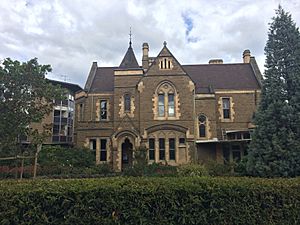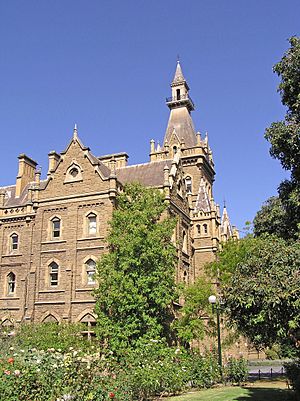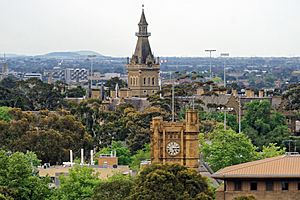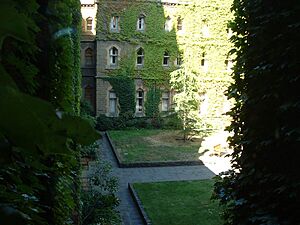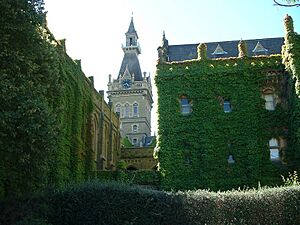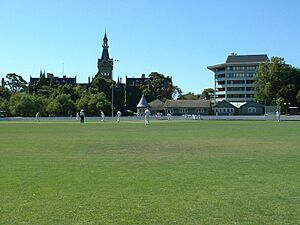Ormond College, Melbourne facts for kids
Quick facts for kids Ormond College |
|||||||
|---|---|---|---|---|---|---|---|
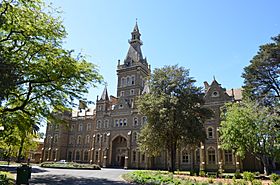
Ormond College from College Crescent
|
|||||||
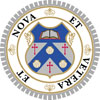 |
|||||||
|
|
|||||||
| University | University of Melbourne | ||||||
| Location | 49 College Crescent, Parkville, Victoria | ||||||
| Coordinates | 37°47′37″S 144°57′49″E / 37.7935°S 144.9635°E | ||||||
| Motto | Et Nova et Vetera (Latin) | ||||||
| Motto in English | Both the New and the Old | ||||||
| Established | 1879 | ||||||
| Master | Dr. Areti Metuamate | ||||||
| Undergraduates | 360 | ||||||
| Postgraduates | 66 | ||||||
Ormond College is a large student home at the University of Melbourne in Australia. It's like a special community where students live, learn, and grow together. Around 350 undergraduate students and 90 postgraduate students live there. Many professors and academic staff also live at the college.
Contents
Discovering Ormond College's Past
How Ormond College Began
The University of Melbourne started in 1853. Land was set aside for student colleges. The Presbyterian Church was given 10 acres of land. This land later became Ormond College.
In 1877, a school headmaster named Alexander Morrison helped get things moving. He wanted to build a college on the land. A fundraising effort began. A kind man named Francis Ormond donated a lot of money. He gave £3,000 to start.
By 1877, the church decided to build the college right away. They wanted it to be a home for university students. It would also be a place for theological studies. More money was raised, and Francis Ormond gave even more. He ended up donating over £22,000!
The first stone of the college was laid on November 15, 1879. The college officially opened on March 18, 1881. Francis Ormond offered to pay for all the remaining buildings.
When it first opened, Ormond College had 20 students. Soon, there were 24. Ormond College was special because it welcomed students of all faiths. This idea of being open to everyone is still important today.
In 1887, Francis Ormond paid for the Victoria Wing. This building was finished in 1889. In 1893, the dining hall, kitchens, and staff areas opened. The dining hall looks like old buildings from famous universities in England. Many people compare it to Hogwarts from the Harry Potter books! An episode of MasterChef was even filmed there in 2013.
Growing Quickly in the 1880s
The college quickly needed more space. Francis Ormond helped again by funding a new wing. Another important building was the Wyselaskie building, finished in 1887. John Dickson Wyselaskie was another generous donor. This building had a lecture hall and homes for professors.
Expanding After World War II
After World War II, many more students wanted to live at Ormond. The college grew to over 150 students. In 1949, they raised money for improvements. The kitchens were updated, and buildings were repaired. In 1955, a squash court was built to remember students who died in the war. A new home for the Master (the head of the college) was built in 1958.
New Ideas and Buildings in the 1960s
In the 1960s, Ormond College continued to build new and interesting structures. In 1961, three octagon-shaped buildings were added. These buildings, called Picken Court, could house about 100 students.
A new library, the MacFarland Library, was built in 1965. The old library became the college chapel. This gave the college its own special place for worship.
In 1968, a bold new building called McCaughey Court was opened. It won awards for its unique design.
Ormond College in the 21st Century
In 2009, Rufus Black became the Master of Ormond College. He brought in many new changes. That year, Ormond started a program to support Aboriginal and Torres Strait Islander students. This program helps them live at Ormond and study at the University of Melbourne.
The college also added new facilities. In 2010, the student common room was updated. In 2011, a new student academic centre opened. It has learning spaces, the college library, and computer facilities. The college also added more rooms for students. They also created special buildings for graduate students in 2014 and 2015.
In 2016, the Wade Institute of Entrepreneurship opened. This institute helps people learn about starting businesses. It offers programs for investors, entrepreneurs, and schools. It even has a special Master's degree in Entrepreneurship.
In 2018, Lara McKay became the Master of Ormond.
Welcoming Women to Ormond College
From the very beginning, Ormond College welcomed women. They could attend classes and join college activities. They did not live at the college at first. Female students were among the first important scholars.
From 1968 to 1972, some female students could live in the college. They helped with duties in return. In 1973, Ormond College officially welcomed women as full-time residents. Women quickly took on leadership roles. They became leaders in student groups and even became the Vice-Master (deputy head of the college).
The Renate Kamener Oration
Renate Kamener was a woman who cared deeply about peace and fairness. She was born in Germany and her family escaped before the Holocaust. She later moved to Australia and became a teacher. She helped start a group called Salaam-Shalom. This group brought Muslim and Jewish women together.
To honor her, the Kamener Family and Ormond College created the Renate Kamener Oration. This event helps Indigenous students achieve their university dreams. It is funded by an annual talk given by important speakers. Past speakers include:
- 2010: Peter Singer
- 2011: Gareth Evans
- 2012: Glyn Davis
- 2013: James Button
- 2014: Mark Dreyfus
- 2015: Marcia Langton
- 2016: Julian Burnside
- 2017: Abdi Aden
- 2018: Tim Costello
- 2019: Julia Gillard
- 2020: (Cancelled – COVID-19 pandemic)
- 2022: Noel Pearson
- 2023: Catherine Liddle
- 2024: Thomas Mayo (22 September)
Leaders of Ormond College
List of Masters
The Master is the head of Ormond College. Here are some of the people who have held this important role:
- 1881–1914 Sir John Henry MacFarland
- 1915–1943 David Kennedy Picken
- 1946–1953 Sir Stanley L. Prescott
- 1954–1958 Brinley Newton-John
- 1959–1979 John Davis McCaughey AC
- 1980–1989 David Henry Parker
- 1990–1993 Alan Gregory AM
- 1994–2008 Hugh Norman Collins
- 2009–2017 Rufus E. R. Black
- 2018–2024 Lara McKay
- 2024 - present Dr. Areti Metuamate
Chairs of the College Council
The College Council helps guide Ormond College. Here are some of its past leaders:
- 1881 - 1903 Alexander Morrison
- 1903 - 1910 Robert Gillespie MP
- 1910 - 1926 John Matthew
- 1926 - 1942 Rev Dr William Borland
- 1942 - 1943 Henry Bremner Lewis
- 1943 - 1943 William Gray
- 1943 - 1944 John Claude McPhee OBE
- 1944 - 1946 Rev John Clark-Jones
- 1947 - 1947 Rev David Seymour Broughton
- 1947 - 1954 Rev John Evan Eric Owen
- 1960 - 1960 Rev L O C White
- 1966 - 1966 J S Coltman
- 1985 - 1991 Hon Sir George Lush QC
- 1991 - 1992 Sir Daryl Michael Dawson AC KBE CB KC
- 1995 - 1998 David William (Bill) Rogers AO
- 1998 - 2001 David Abraham AM
- 2010 - 2022 Andrew Michelmore AO
- 2022 - Current Richard Loveridge
Famous People Who Studied at Ormond College
Many people who went to Ormond College have become famous in different fields.
Politics and Government
- Neil Brown KC – A politician who was Australia's Attorney General.
- John Button – A politician who was a senior minister in the Australian government.
- Mark Dreyfus KC — Australia's Attorney General.
- Sir Littleton Groom KCMG KC — A federal minister and Speaker in Parliament.
- Greg Hunt — A federal minister for health.
- Richard Marles — The Deputy Prime Minister of Australia.
- Sir Robert Menzies KT AK CH QC FRS FAA – A Prime Minister of Australia.
- Alan Tudge — A Minister for Education.
Law
- Sir Keith Aickin KBE QC — A judge of the High Court of Australia.
- Alex Chernov AC KC — A Supreme Court judge and Governor of Victoria.
- Sir Daryl Michael Dawson AC KBE CB KC — A former judge of the High Court of Australia.
- Kenneth Hayne AC KC — A former judge of the High Court of Australia.
- Kate Jenkins AO — Australia's federal sex discrimination minister.
- Sir John Latham GCMG PC QC — A politician and judge who was the Chief Justice of Australia.
- Alastair Nicholson AO RFD KC — A retired judge who was the Chief Justice of the Family Court of Australia.
- Sir Henry Winneke AC KCMG KCVO QC — A Supreme Court judge and Governor of Victoria.
Business Leaders
- David Crawford AO — A well-known businessman and company director.
- Charles Goode AC — A stockbroker and company director.
- Andrew Michelmore AO — A mining executive and company director. He also won a gold medal in rowing!
- Ziggy Switkowski AO FAA FTSE — A business executive and nuclear physicist, who was the CEO of Telstra.
Academics and Scholars
- Sir Zelman Cowen AK GCMG GCVO PC QC FTSE – A legal scholar and university leader who was the Governor-General of Australia.
- Graeme Davison AO FASSA FAHA – An Australian historian.
- Andrew Bruce Holmes AC FRS FAA FInstP — A research chemist and professor.
- Peter Singer AC is a moral philosopher and professor at Princeton University.
Military Heroes
- Colonel Sir Edward "Weary" Dunlop AC, CMG, OBE — An Australian World War II hero and surgeon.
- Major General Harold "Pompey" Elliott CB, CMG, DSO, DCM, VD — A senior officer in the Australian Army during WWI.
- General Peter Gration AC, OBE, FTSE — An Australian Army officer who was Chief of the Defence Force.
Medical Professionals
- Sir Frank Macfarlane Burnet OM AK KBE FRS FAA FRSNZ — An Australian scientist who won a Nobel Prize in medicine.
- Brigadier Sir Neil Hamilton Fairley KBE FRS CStJ FRACP FRCP FRCPE — A doctor and army officer who saved many lives from diseases like malaria.
- Revd John Flynn OBE — He founded the Royal Flying Doctor Service of Australia. He is featured on the Australian $20 note.
Sports Stars
- Jim Howden — An Australian rower who won an Olympic bronze medal.
- Charles Littlejohn MC — An Olympic silver medalist in rowing.
- Paul Sheahan AM — A famous test cricketer.
- James Sutherland — The CEO of Cricket Australia.
Media and Arts
- Graeme Blundell — An actor, director, and writer.
- John Duigan — A film director.
- Phil Harvey — The manager of the famous band Coldplay.
- Mark Seymour — A singer and musician from the band Hunters & Collectors.
Rhodes Scholars
The Rhodes Scholarship is a very special award that allows students to study at Oxford University in England. Many Ormond College students have received this scholarship:
- John Seitz (1906)
- Charles Littlejohn (1909)
- Neil MacNeil (1914)
- Donald Sandral (1916)
- Patrick Hamilton (1917)
- William Hancock (1920)
- Lindsay Ride (1922)
- George Paton (1926)
- Kenneth Wheare (1929)
- Richard Latham (1931)
- Ross Campbell (1933)
- Alan Treloar (1940)
- Zelman Cowen (1941)
- Hugh Stretton (1946)
- Alan Serle (1947)
- Robert Shaw (1948)
- Graeme Davison (1964)
- Alistair Christie (1967)
- Kenneth Hayne (1969)
- Colin Norman (1970)
- Graham Hutchinson (1971)
- Martin Wardrop (1974)
- Andrew Michelmore (1976)
- Richard Caro (1978)
- Michael Penington (1980)
- Ralph King (1982)
- Sharon Korman (1983)
- Timothy Orton (1986)
- Mark Moshinsky (1988)
- Mark Chiba (1989)
- Rufus Black (1991)
- Catherine Anderson (1992)
- Joanna Masel (1997)
- Kate Brennan (2007)
- John Feddersen (2008)
- Kate Robson (2008)
- Hamish McKenzie (2015)
- Bede Jones (2017)
- Rebecca Duke (2017)
- Brigid O’Farrell-White (2018)
- Mattea Mrkusic (2019)
Fulbright Scholars
The Fulbright Scholarship is another important award that allows students to study in the United States. Here are some Ormond College students who have received it:
- Zelman Cowen (1936)
- Daryl Dawson (1951)
- Charles Goode (1959)
- Rodney Crewther (1964)
- Bruce McKellar (1973)
- Robert Bartnik (1974)
- Hilary Charlesworth (1974)
- Ted Gott (1981)
- Greg Hunt (1985)
- Fraser Cameron (1995)
- Paul R. Burgess (2009)
- Rachel Heenan (2015)


